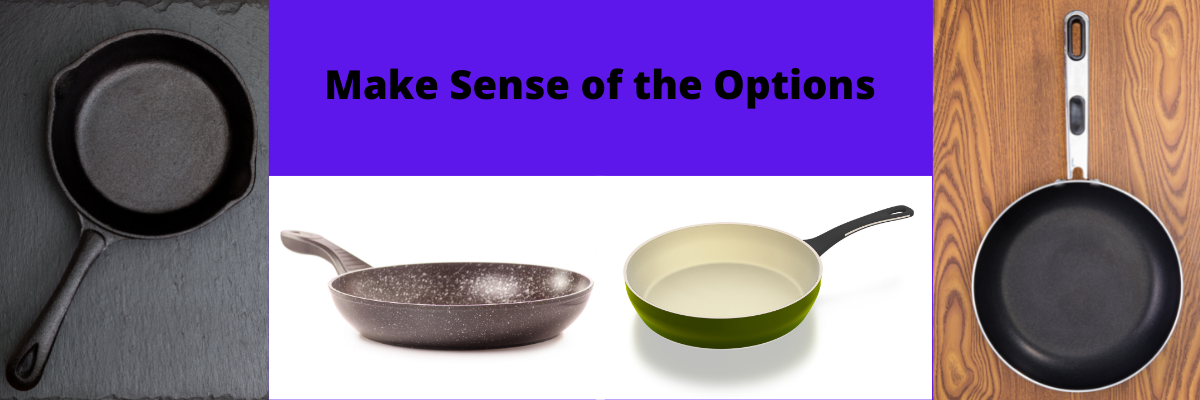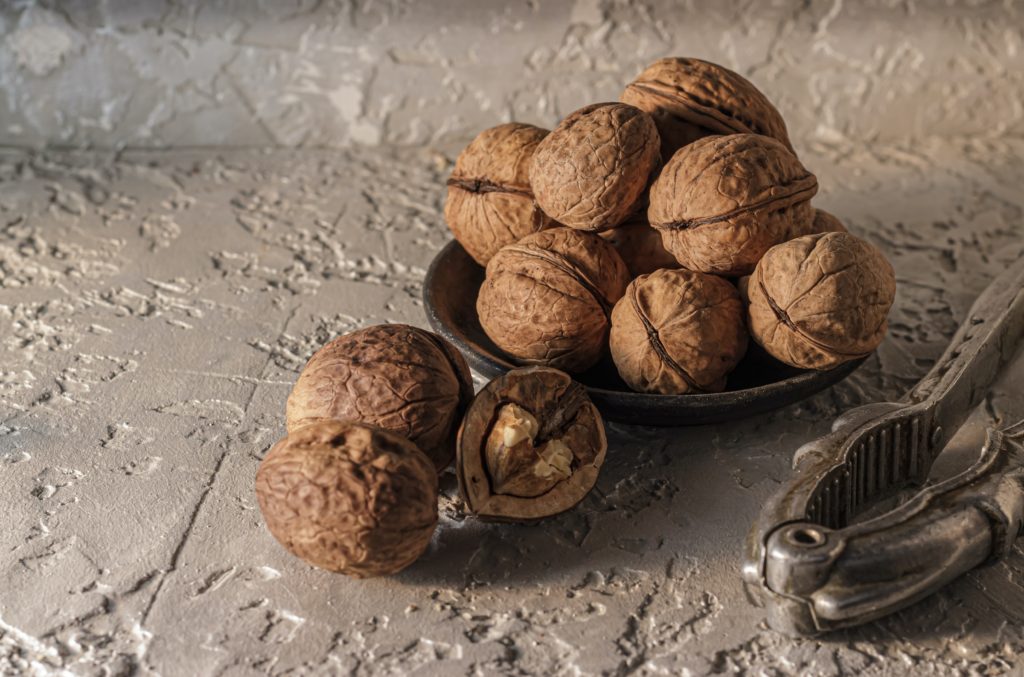Cookware Composition
Have you ever started a pot of water for pasta and wondered if it will ever start to boil? Have you ever noticed one of your pans has a hot spot that causes your food to cook unevenly? Have you ever gotten frustrated because you accidentally scratched off some of the non-stick surfaces on your pan? All these issues can be improved or eliminated with the right knowledge and equipment to fit your kitchen needs! Understanding cookware composition is the first step in building your own collection!
Join me as I help you navigate the innovative and traditional world of cookware composition! I will discuss the various numbers and materials for ply, lids, handles, and other features as well as a few tools that work wonderfully to make cooking more of a joy.
Making Sense of Material Options
| MATERIAL | Works with Induction | Non-Stick | What I Like | What I Don’t Like | I Use This For |
| Ceramic | ❌† | ✅ | *Considered a healthier, non-stick surface compared to Teflon * Easy to clean | *Beware of deep scratching in the ceramic coating which can expose food to potentially harsh metals *Less efficient heat distribution | I use one of these to make eggs…any style…even if I have to make several kinds it is easy to wipe clean and start again! |
| Cast Iron | ✅† | ✅ | *Can be inexpensive and very well made *Heavy Duty and long-lasting * Excellent Heat Retention | *You must make sure it is completely dry after each use to prevent rust *Re-seasoning is essential to maintaining the life and non-stick surface of the cookware | These really shine with anything with a filling that has a crust or biscuits on top that need to finish in the oven. |
| Glass | ❌† | ✅ | *Works well in the oven *Does not react with acidic foods *Leftovers can be stored safely without dirtying another dish. *You can see your food cook from all angles *Dishwasher Safe | *Glass can have inconsistencies in it that can cause uneven cooking *It breaks easily *May not be able to handle direct high heat like that from coil-top burners or broilers *Typically do not have handles that are heat resistant. | I typically use glass for baking. |
| Clay/Stone | ✅† | ✅ | * Eco friendly and safe * Excellent Heat Retention *Highly resistant to scratches *non-porous, and does not react to foods as some metals do *even heat distribution | *Can be very expensive *Not suitable for high heat as it can damage the coating | I only use clay/stone for baking. Maybe I will try it for cooking someday. |
| Aluminum | ❌† | ✅ | *Very inexpensive *Lightweight *Highly heat conductive | *Direct contact reacts with acidic foods such as citrus fruits, vinegar, and tomatoes which leaves a bitter, metallic flavor | I only use Aluminum as an inner core metal with a different coating on the outside. |
| Copper | ❌† | ✅ | *Love the rustic look of copper cookware-especially the textured ones *Excellent Heat distribution | * Like Aluminum, direct contact reacts with acidic foods such as citrus fruits, vinegar, and tomatoes which leaves a bitter, metallic flavor — An inner lining of tin or stainless steel is common to remedy this issue *Very expensive | I dream of someday having a kitchen fully stocked with a set of copper cookware–and maybe a hammered copper sink and light fixtures! 😉 |
| Stainless Steel | ✅† | ❌ | *easy to keep looking like new with a scouring pad and soap *heats evenly | Quality varies so much-which can be confusing. Some are great, but others can deteriorate quickly. For more details on the differences, check out this article that breaks it down. | I use it for searing meats and one-pan meals that need finish in the broiler. |
| Enameled Cast Iron | ✅† | ✅ | All the benefits of cast iron, but with a smooth, easy to clean surface | Beware the rim that is not covered in enamel, because it can still rust! Make sure it is dry quickly after cleaning. | I use these for slow cooking in the fall. I’m cold, the house needs warmth, why not let the chili simmer in this baby on the stove? |
| Non-Stick Stainless Steel Hybrid Cookware | ✅† | ✅ | I love the non-stick and stainless steel combo! No need to worry about scraping the bottom of the pan with a utensil. | *not good with high heat, so no searing and no oven *be aware that any non-stick surface that does not have the honeycomb grid is highly susceptible to peeling off the pan–high heat can cause it to peel on its own! | I use these for one-pan meals that use ground meat because they do not require high heat. I recommend getting one that has an outer rim that is not non-stick so you can tap utensils on it without hurting the coating. |

Tri, 5, and 7-Ply, Oh, My!
In the cookware world, layers are commonly referred to as “ply”. These are the layers of material that make up the cooking surface area from top to bottom. Tri-ply cookware is generally composed of a layer of heat-conducting metal (typically aluminum because it is highly reactive to changes in temperature) between layers of sturdy metal on top and bottom (typically stainless steel because it is not prone to warping or chemical reactions). These layers are bonded with a microscopic layer of a bonding metal. Some marketing teams tote these as 5-Ply, even though they have the same composition as their competitor counterparts. Other times, the ply count is solely based on the layers that would be visible to the naked eye (if we were to cut open the pan), so in this case, the layers for a 5-ply could be (for example) stainless steel, aluminum, copper, aluminum, stainless steel. For 7-Ply, generally, just add another layer of each.
The idea behind the additional layers is that separating the metals that are highly reactive to temperature allows for a more consistent cooking temperature. When a cool piece of meat is set in a hot pan to sear, the temperature is bound to drop since much of the heat will be distributed into the meat on contact. The extra layers will allow, in theory, for the pan to maintain the heat longer. While some argue that the pan would take longer to heat in the first place, others point out that the total thickness of the heat reactive layers ends up performing just as well as a single layer of the same thickness. Therefore, if a 7-Ply pan were comprised of the same total thickness of aluminum as a similar Tri-Ply pan, then the heat conductivity of both would be too close to notice.
Based on your cooking surface preferences, you can now start to consider everything you are looking for in cookware…
Cookware Handles: Material DOES Matter
For handles, there are 2 things to keep in mind. If a handle is oven-proof, then it is probably heat-conductive. I like to have some pans with metal handles for use in the oven as well as the stovetop. I also like to have some pans with handles that are not going to burn me if I grab them. You can be the judge as this is a completely personal preference!
Cookware Lids: What Kinds will Work for You?
Personally, I love a great pan with a glass lid. I like to see my food through the lid. One downside of this is the glass has a frame of either silicon or metal or both…the seal between them can get yucky if washed in a dishwasher–or even with normal use. Other pans have lids that are made of similar materials to the pan. Either way, you will want to think about storage. Nesting pans are tricky when you add lids to the mix. Consider lids with handles that allow for hanging or racks that house lids on display or in a cabinet.

Cookware Composition in a Nutshell (Almost)
When it comes to the basic anatomy of a kitchen pan, make sure it is durable on the outside and heat-conductive on the inside. This will allow for even heat and beautiful cookware that can last a lifetime! It is important to choose cookware that fits your cooking and storage needs.
But That’s Another Blog (Post)
As I wrote this post, one thing had me thinking—If aluminum is used for its heat conduciveness, then why is aluminum foil cool to the touch when cooking? —but I think that might be a topic for jiffytalking another day!
(This post contains affiliate links. As an Amazon Associate I earn from qualifying purchases.)
